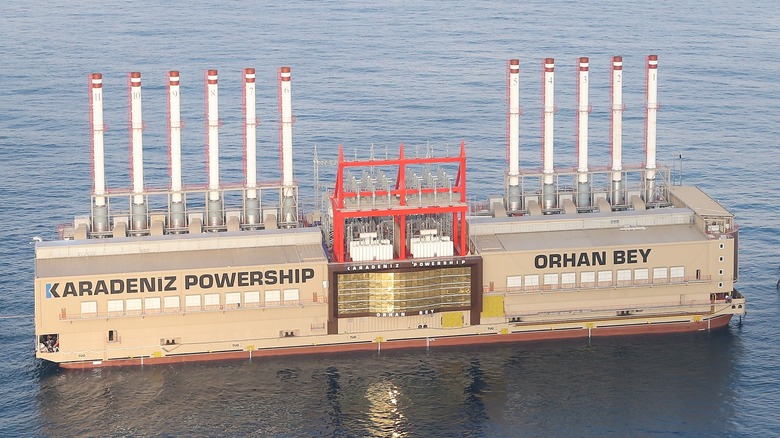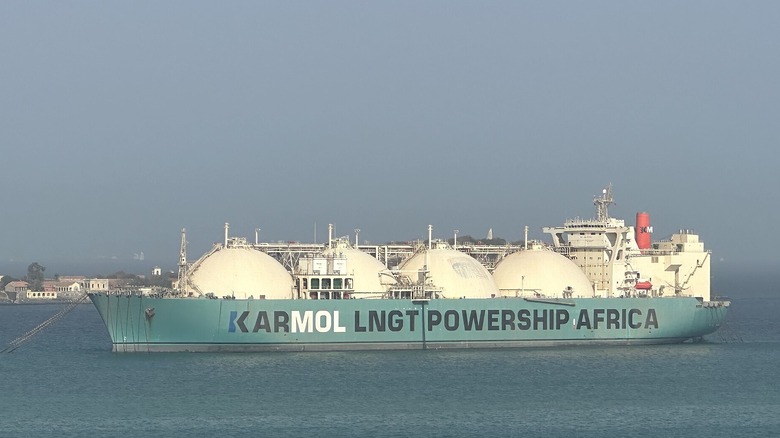What Is A Powership And Why Do Some Countries Need Them?
Ships come in all shapes and sizes, from behemoths like the largest aircraft carrier in the world — the USS Gerald R. Ford – to diminutive tugboats; each ship has a size and a design that fits its purpose. Perhaps one of the most unusual types of ship to be found on the oceans is a powership. These ships are — as the name suggests — designed to sit offshore and generate power that can then be fed into an onshore power grid.
The emergence of the powership is not a new phenomenon. Indeed, General Electric developed powerships for use in WW2. However, recent times have seen a massive increase in the production and development of powerships. This is largely down to their convenience in an increasingly power-hungry world. Their mobility allows them to be quickly and easily deployed in areas where there is inadequate onshore power generation. This can be down to poor or damaged infrastructure.
For example, in 2010, Iraq started used powerships to help its ailing and damaged electrical infrastructure, which in the summer months can fall 18,000 megawatts short of demand. They can also be used as a cost-effective way to replace inefficient and outdated power plants with cleaner, scalable, and more efficient alternatives. Finally, they can also be used to plug "power gaps" as countries make the often difficult transition to renewable energy sources. Let's take a closer look at these electrifying ships and the service they provide.
Powerships bring power to the people
The main company supplying powerships is the Turkish company Karpowership. It's the world's only owner/operator of a fleet of powerships; it also builds its own fleet of ships across various Istanbul shipyards. It currently maintains a fleet of 50 powerships that can generate over 10,000 megawatts of electricity across the entire fleet (one megawatt is enough to power about 200 American homes). The company doesn't sell these ships; rather, it rents them to whatever country needs them. Among the countries that have rented powerships from Karpowership is the aforementioned Iraq, but it also includes Lebanon, Cuba, Senegal, Indonesia, and Mozambique, to name a few.
The ships they offer come in a range of classes. These range from the smallest "Seal" class, which offers a generating capacity of up to 40 megawatts, to the largest "Khan" class, which can generate up to 470 megawatts. For comparison, an average large onshore power plant will generate anywhere from several hundred megawatts to over 1,000. The Khan class of ship is truly gigantic — these generating giants can be up to 984 feet long (300 meters) and can carry 38,000 metric tons of fuel. An example of the Khan class is the Osman Khan, which can use dual fuels, including heavy oil and natural gas, to supply electricity. Despite these sizes, the ships have a relatively short draft of just 16 to 23 feet, which is important for allowing them access to shallower ports.
How do powerships work
If you've used a portable generator for electricity, then you've used a scaled-down version of a powership. These are essentially floating generators that take fuel and turn it into electricity. Once moored at a suitable location, the vessel connects to existing onshore electricity infrastructure through power lines. Effectively, these ships are turnkey; the ship turns up, the company sets everything up, and the powership can begin to supply energy. One of the big advantages of these vessels is their flexibility; they can operate on heavy fuel oil, refined fuel oil, or natural gas. Historically, there was even a converted liberty ship — one of the most important ships of WW2 — that used a nuclear reactor to supply power for the Panama Canal Zone from 1968 to 1976, proving again that powerships are far from being a new concept.
With the current generation of ships, the capability of using different fuel types is one of the big advantages. The dual fuel capability of modern ships allows them to operate more efficiently and use the best choice of fuel for their current location. It's this efficiency and minimal investment in onshore electricity infrastructure that has seen the use of powerships soar. For example, in 2015 and 2016, Karpowership signed five contracts to supply 1000 megawatts of electricity to four Indonesian islands. These supply between 10% and 80% of each island's electricity demands. In short, these ships are helping to keep the lights on when traditional infrastructure is struggling to.


